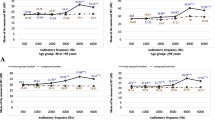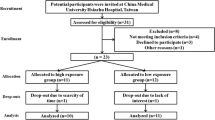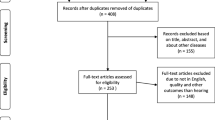Abstract
We aimed to estimate the prevalence of hearing loss and influencing factors among workers in automobile manufacturing industry in Wuhan, China. We conducted cross-sectional analyses of 2017 through 2019 data from survey of the key occupational diseases on 17,176 workers in automobile manufacturing industry, Wuhan, China. Hearing loss was defined as a pure tone mean of 25 dB or higher in either ear at 0.5, 1, and 2 kHz for speech frequency and at 3, 4, and 6 kHz for high frequency. Among the 17,176 workers, more than a quarter of participants had high frequency hearing loss, and 6.41% had speech frequency hearing loss. The prevalence of hearing loss was higher among participants with diabetes mellitus and current smoking, temporary tinnitus, and sudden change in hearing. Compared with the controls, age (OR = 1.08, 95% CI = 1.08–1.09), male (OR = 1.40, 95% CI = 1.21–1.63), occupational noise exposure (OR = 1.19, 95% CI = 1.08–1.30), having temporary tinnitus (OR = 1.20, 95% CI = 1.08–1.33), and having sudden change in hearing (OR = 1.58, 95% CI = 1.20–2.08) were associated with higher prevalence of high frequency hearing loss; meanwhile, age (OR = 1.09, 95% CI = 1.08–1.09), male (OR = 1.38, 95% CI = 1.11–1.71), having family history of hearing loss (OR = 2.84, 95% CI = 1.35–5.97), and having sudden change in hearing (OR = 2.58, 95% CI = 1.80–3.70) were associated with higher prevalence of speech frequency hearing loss. No additive and multiplicative interaction was found between occupational noise and these factors for hearing loss. Hearing loss directly affects 25% of workers in automobile manufacturing industry in Wuhan. Measures should be implemented for the control of occupational noise and other factors simultaneously in the workplace.


Similar content being viewed by others
Data availability
Data are available from the corresponding author upon reasonable request and with permission.
Abbreviations
- NIHL:
-
Noise-induced hearing loss
- WHO:
-
World Health Organization
- NHIS:
-
National Health Interview Survey
- AFFH:
-
Agriculture, Forestry, Fishing, and Hunting
- SD:
-
Standard deviation
- OR:
-
Odds ratio
- CI:
-
Confidence interval
- RERI:
-
Relative excess risk due to interaction
References
Agrawal Y, Platz EA, Niparko JK (2008) Prevalence of hearing loss and differences by demographic characteristics among US adults: data from the National Health and Nutrition Examination Survey, 1999-2004. Arch Intern Med 168:1522–1530
B. S-KMG Contribution of genetic factors to noise-induced hearing loss. 10th international congress on noise as a public health problem of the international commission on biological effects of noise, London, UK, 2011
Basner M, Babisch W, Davis A, Brink M, Clark C, Janssen S, Stansfeld S (2014) Auditory and non-auditory effects of noise on health. Lancet 383:1325–1332
Bento RF, Sousa NC (2019) Hearing health: a major concern for the 21 (st) century. Int Arch Otorhinolaryngol 23:e254–e255
Brink LL, Talbott EO, Burks JA, Palmer CV (2002) Changes over time in audiometric thresholds in a group of automobile stamping and assembly workers with a hearing conservation program. AIHA J 63:482–487
Degeest S, Corthals P, Vinck B, Keppler H (2014) Prevalence and characteristics of tinnitus after leisure noise exposure in young adults. Noise Health 16:26–33
Dobie RA (2008) The burdens of age-related and occupational noise-induced hearing loss in the United States. Ear Hear 29:565–577
Gordon-Salant S (2005) Hearing loss and aging: new research findings and clinical implications. J Rehabil Res Dev 42:9–24
Groenewold MR, Masterson EA, Themann CL, Davis RR (2014) Do hearing protectors protect hearing? Am J Ind Med 57:1001–1010
Health NIo (1990) Consensus Development Conference Statement: noise and hearing loss. Bethesda, MD; U.S. Department of Health & Human Services
Health. NIo (1990) Consensus Development Conference Statement: noise and hearing loss. Bethesda, MD; U.S. Department of Health & Human Services
Hong O, Chin DL, Ronis DL (2013) Predictors of hearing protection behavior among firefighters in the United States. Int J Behav Med 20:121–130
Kerr MJ, Savik K, Monsen KA, Lusk SL (2007) Effectiveness of computer-based tailoring versus targeting to promote use of hearing protection. Can J Nurs Res 39:80–97
Li W (2016) Hearing loss: an important global health concern. Lancet 387:2351
Lie A, Skogstad M, Johannessen HA, Tynes T, Mehlum IS, Nordby KC, Engdahl B, Tambs K (2016) Occupational noise exposure and hearing: a systematic review. Int Arch Occup Environ Health 89:351–372
Masterson EA, Themann CL, Calvert GM (2018) Prevalence of hearing loss among noise-exposed workers within the agriculture, forestry, fishing, and hunting sector, 2003-2012. Am J Ind Med 61:42–50
Mirza R, Kirchner DB, Dobie RA, Crawford J, Loss ATFoOH (2018) Occupational noise-induced hearing loss. J Occup Environ Med 60:e498–e501
Nelson DI, Nelson RY, Concha-Barrientos M, Fingerhut M (2005) The global burden of occupational noise-induced hearing loss. Am J Ind Med 48:446–458
Richardson DB, Kaufman JS (2009) Estimation of the relative excess risk due to interaction and associated confidence bounds. Am J Epidemiol 169:756–760
Samant Y, Parker D, Wergeland E, Wannag A (2008) The Norwegian labour inspectorate's registry for work-related diseases: data from 2006. Int J Occup Environ Health 14:272–279
Stucken EZ, Hong RS (2014) Noise-induced hearing loss: an occupational medicine perspective. Curr Opin Otolaryngol Head Neck Surg 22:388–393
Tak S, Calvert GM (2008) Hearing difficulty attributable to employment by industry and occupation: an analysis of the National Health Interview Survey--United States, 1997 to 2003. J Occup Environ Med 50:46–56
Tambs K, Hoffman HJ, Borchgrevink HM, Holmen J, Engdahl B (2006) Hearing loss induced by occupational and impulse noise: results on threshold shifts by frequencies, age and gender from the Nord-Trøndelag Hearing Loss Study. Int J Audiol 45:309–317
Toppila E, Pyykkö II, Starck J, Kaksonen R, Ishizaki H (2000) Individual risk factors in the development of noise-induced hearing loss. Noise Health 2:59–70
Verbeek JH, Kateman E, Morata TC, Dreschler WA, Mischke C (2012) Interventions to prevent occupational noise-induced hearing loss. Cochrane Database Syst Rev 10:Cd006396
Wang D, Zhou Y, Ma J, Xiao L, Cao L, Zhou M, Kong W, Wang Z, Li W, He M, Zhang X, Guo H, Yuan J, Chen W (2019) Association between shift work and hearing loss: the Dongfeng-Tongji cohort study. Hear Res 384:107827
WHO. Prevention of deafness and hearing impaired grades of hearing impairment. http://www.who.int/pbd/deafness/hearing_impairment_grades/en/index.html. Accessed date 25 Aug 2018
Wilson BS, Tucci DL, Merson MH, O'Donoghue GM (2017) Global hearing health care: new findings and perspectives. Lancet 390:2503–2515
Funding
The study was supported by the National Natural Science Foundation of China (81903291) and the Fundamental Research Funds for the Central Universities (2019kfyXJJS032). The funder did not play any role in study design; in the collection, analysis, and interpretation of data; in the writing of the report; nor in the preparation, review, or approval of the manuscript.
Author information
Authors and Affiliations
Contributions
Wenzhen Li and Dongming Wang performed the topic design and literature search, and Wenzhen Li analyze data and draft the manuscript. Zhenlong Chen and Guilin Yi contributed to collect data. Zhiya Zhao contributed to the collation. Dongming Wang and Zuxun Lu contributed to the revision of manuscript.
Corresponding author
Ethics declarations
Ethics approval and consent to participate
The study was approved by the Tongji Medical College Institutional Review Board ([2019] IEC (S342)), and all participants provided written informed consent.
Consent for publication
Not applicable.
Competing interests
The authors declare no competing interests.
Additional information
Responsible Editor: Lotfi Aleya
Publisher’s note
Springer Nature remains neutral with regard to jurisdictional claims in published maps and institutional affiliations.
Rights and permissions
About this article
Cite this article
Li, W., Zhao, Z., Chen, Z. et al. Prevalence of hearing loss and influencing factors among workers in Wuhan, China. Environ Sci Pollut Res 28, 31511–31519 (2021). https://doi.org/10.1007/s11356-021-13053-y
Received:
Accepted:
Published:
Issue Date:
DOI: https://doi.org/10.1007/s11356-021-13053-y




